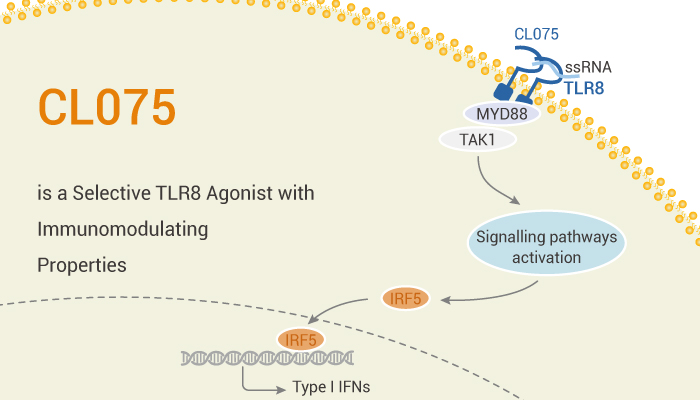Toll-like receptors (TLRs) are a group of pattern recognition receptors for innate immune cells to detect various pathogen-associated molecular patterns. To date, ten TLRs have been identified in human cells and 13 identified in murine cells. TLR7 and 8 (TLR8) recognize viral single-stranded RNA and small molecular weight agonists to activate anti-viral immune responses. They recognize RNA viruses such as dengue, influenza, VSV, and Newcastle disease virus. TLR7 agonists directly activate plasmacytoid dendritic cells and, to a lesser extent, monocytes. Conversely, TLR8 agonists directly activate myeloid dendritic cells, monocytes, and monocyte-derived dendritic cells (GM-CSF/IL-4/TGF-beta). In this study, CL075 (3M002) is a selective TLR8 agonist with immunomodulating properties. It preferentially activates NF-κB through TLR8 at 3 μM. In addition, CL075 triggers a MyD88-dependent signaling pathway to elicit the production of inflammatory cytokines and type I interferons (IFNs) via activation of NF-κB and IRF7, respectively.

CL075 is a selective TLR8 agonist with immunomodulating properties.
CL075 (2 μM; 4 h) induces the production of IL-6, IL-8, and IFN-γ in rabbit splenocytes. It induces the total IgM production and cell proliferation in rabbit splenocytes. It also activates the rabTLR8 in 293 cells. Meanwhile, CL075 activates a mild antigen-specific antibody response in rabbits. Moreover, CL075 induces similar cytokine profiles from human PBMC. It effectively stimulates cytokine production from mDC. It also effectively stimulates cytokine production from monocytes and monocytederived DC (Mo-DC). CL075 also induces enhancement of fMLF-induced superoxide anion production. Furthermore, CL075 induces the phosphorylation of p47phox on the same sites. In addition, it induces activation of Pin1, which is necessary for CL075-induced priming.
In summary, CL075 is a selective TLR8 agonist with immunomodulating properties. CL075 triggers a MyD88-dependent signaling pathway to elicit the production of inflammatory cytokines and type I interferons (IFNs) via activation of NF-κB and IRF7, respectively.
Reference:
Gorden KB, et al. J Immunol. 2005;174(3):1259-1268.;Maalej KM, et, al. J Leukoc Biol. 2015 Jun;97(6):1081-7.